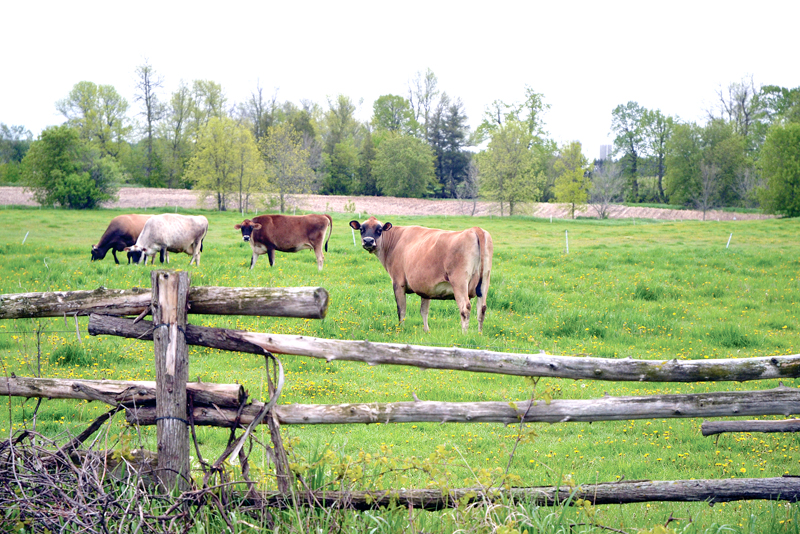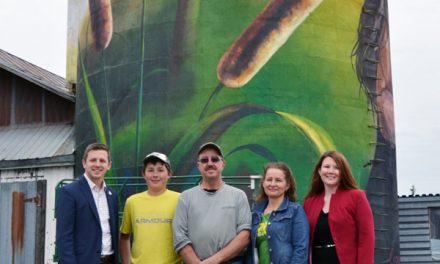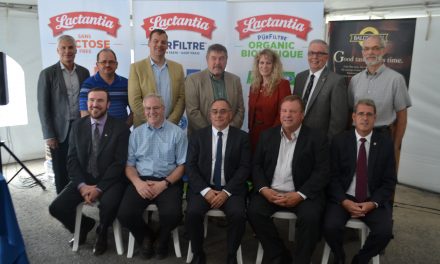There have been some highs and lows over the last year in the dairy industry. On the bright side, the demand is strong and the Dairy Farmers of Ontario have been hard at work bringing on a marketing strategy to increase fluid milk sales, while working with retailers to continue the popularity of Ontario cheese, butter and other dairy products. Sawyer Helmer photo
SOUTH MOUNTAIN – Heading into June’s dairy month the AgriNews had the opportunity to sit down with Dairy Farmers of Ontario (DFO) board member Nick Thurler. Thurler works on the Audit Committee, Markets and Allocation Committee, the Quota Committee, the Ontario Advisory Committee for Milk and is a DFO representative for the P5 Quota Committee.
Trade deals: the good, the bad and the ugly
“The big one is CUSMA,” said Thurler who added that he had received an email in early May indicating the deal might not be signed. Tensions had been running high between Prime Minister Justin Trudeau and President Donald Trump due to tariffs on steel and aluminium but a resolution, lifting the tariffs was reached in late May. CUSMA’s ratification was in question with the tariffs in place but now progress may be made in completing the trade deal.
“I thought Freeland was really working a deal for us but she gave everything up at the end. That was the most negative [point of the year],” said Thurler.
On the positive side, there is still growth in the industry and Thurler said the demand is strong. However, that positive is somewhat short lived as the three trade deals – CETA, CPTPP and CUSMA – mean the growth is given away.
“In six years from now if CUSMA happens it is 8.5 per cent that we are not going to get. Last year we grew three per cent and change and I still think we will be about two per cent this year on top of the stuff that is coming in from CPTPP or CETA. The thing about the growth is that it is our best milk. It’s the last milk out of the tank and it’s milk that you don’t have to buy quota for,” said Thurler.
Trade tensions also put pressure on the world price and means margins are getting tighter. Thurler explained that 27 to 28 per cent of Ontario milk is priced at the world price, which means if the U.S. and China trade tensions continue, the world price and then brand price could be affected. Ensuring producers can stay ahead of these tighter margins means taking advantage of industry growth. However, when growth is given away producers have fewer opportunities to stay ahead.
Despite the loss of Class 7 from the CUSMA, Thurler said there is a committee created from producers and processors who are working with the government to ensure Class 7 is absorbed into the other classes. “Everything that was sold through Class 7 for the domestic market needs to be worked out in the price and in the different classes so that protein still gets used for the domestic market,” he said.
Milk marketing
DFO announced this year that they would be pulling Ontario promotion dollars from the Dairy Farmers of Canada (DFC) after they couldn’t provide DFO with a breakdown of where the money was being spent. Thurler said DFO is still working with DFC as $45-million of the $105-million budget has left a “big hole”.
The money that is now in Ontario has been used to hire a marketing expert who has begun hiring a team to help build Ontario milk’s brand. The first section of the campaign was launched on April 22 and the total marketing fund will be spent in five sections. Thurler said some will still be sent to DFC, 25 per cent is for the Dairy Done Right branding, 20 per cent is to consumer programs, 15 per cent for community programs and then 30 per cent for business development to work with processors or retailers. Thurler added that retailer programs include an agreement with Longos, based in the Greater Toronto Area, for an Ontario cheese section in 27 of their stores.
Ontario producers will be presented with the financial breakdown of marketing dollars at the AGM in the first week of January, a first for the organization.
The rebranding will also focus on innovation for fluid milk sales. “I think it’s great. Milk has been in a carton for 50 or 60 years. You look at any other company that sells stuff they have to innovate all the time to keep the sales up. I don’t know if that’s why our sales [are down] but the only ones that are going down is the fluid milk. Butter, cheese and all that is on the up but it is tough to compete with [other options to fluid milk],” said Thurler. “We are pretty excited about the market and we will see if we can turn the fluid milk around. Ever since I’ve been at DFO I’ve been talking about how we should sell milk in a bottle.”
Animal welfare
Since the OSPCA Act was ruled unconstitutional at the beginning of 2019, animal welfare claims have been directed to the police. Thurler said the DFO is part of the discussion with government to determine which organization should take over animal welfare investigations and concerns.
As with the OSPCA Act, a DFO representative is required to accompany police to investigate a claim on Ontario dairy farms. “[The field reps] are trained to take care of that,” said Thurler.
Quota review
Next spring the DFO will release proposed changes for the quota review that will come into effect on Aug. 1, 2020. Thurler said the biggest change is a proposed reduction of the 10 days up and 30 days down system to 10 days up and 15 days down.
Currently, producers can fall behind by a month, filling their quota, however Thurler said changes need to be made so producers cannot go back too far. The last few years the industry saw a spike of 22 per cent growth that drove the DFO to boost available quota to meet the demand. “When I was looking at all that growth, we probably put too much quota in trying to keep up with the demand,” said Thurler. “Now it is putting a bit of pressure on the system because there is plenty of milk for the demand. This is why we have to cut the quota down a bit this year.”












